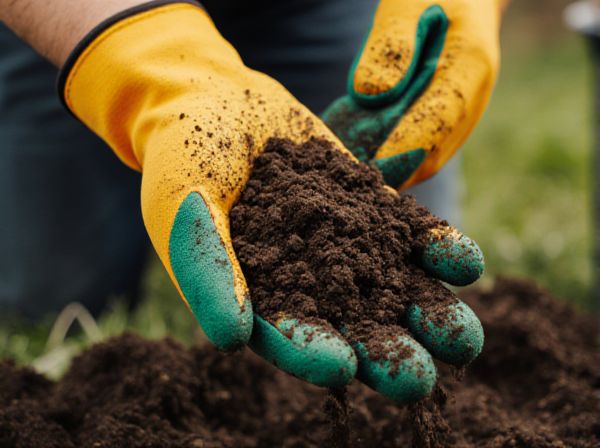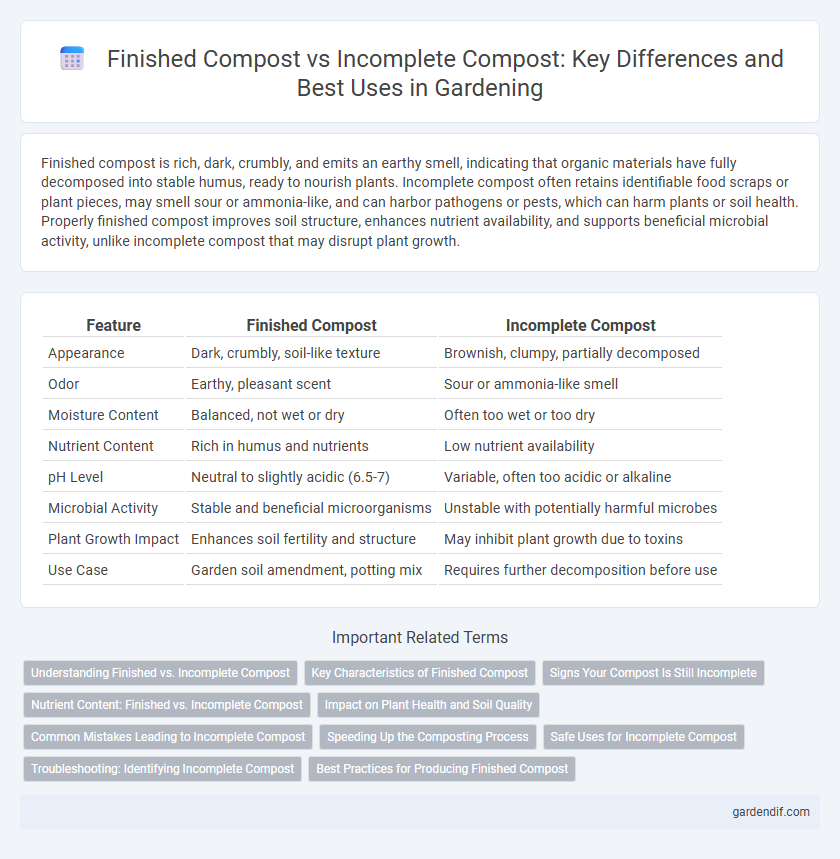
Finished compost vs Incomplete compost Illustration
Finished compost is rich, dark, crumbly, and emits an earthy smell, indicating that organic materials have fully decomposed into stable humus, ready to nourish plants. Incomplete compost often retains identifiable food scraps or plant pieces, may smell sour or ammonia-like, and can harbor pathogens or pests, which can harm plants or soil health. Properly finished compost improves soil structure, enhances nutrient availability, and supports beneficial microbial activity, unlike incomplete compost that may disrupt plant growth.
Table of Comparison
| Feature | Finished Compost | Incomplete Compost |
|---|---|---|
| Appearance | Dark, crumbly, soil-like texture | Brownish, clumpy, partially decomposed |
| Odor | Earthy, pleasant scent | Sour or ammonia-like smell |
| Moisture Content | Balanced, not wet or dry | Often too wet or too dry |
| Nutrient Content | Rich in humus and nutrients | Low nutrient availability |
| pH Level | Neutral to slightly acidic (6.5-7) | Variable, often too acidic or alkaline |
| Microbial Activity | Stable and beneficial microorganisms | Unstable with potentially harmful microbes |
| Plant Growth Impact | Enhances soil fertility and structure | May inhibit plant growth due to toxins |
| Use Case | Garden soil amendment, potting mix | Requires further decomposition before use |
Understanding Finished vs. Incomplete Compost
Finished compost exhibits a dark, crumbly texture with no recognizable food or plant material, indicating complete organic matter breakdown by microbes. Incomplete compost retains visible scraps or a sour odor, signifying ongoing decomposition and potential phytotoxicity if applied prematurely. Properly finished compost enhances soil fertility and structure, while incomplete compost may harm plants and attract pests.
Key Characteristics of Finished Compost
Finished compost is dark, crumbly, and earthy-smelling, indicating full decomposition of organic materials with stable nutrient content. It exhibits balanced moisture levels, high microbial activity, and absence of visible feedstock, ensuring its suitability as a soil amendment. Incomplete compost retains recognizable plant matter, has uneven texture, and may produce unpleasant odors due to ongoing microbial breakdown and potential phytotoxicity.
Signs Your Compost Is Still Incomplete
Signs your compost is still incomplete include visible food scraps, a strong ammonia or sour odor, and a damp, slimy texture that indicates ongoing decomposition. Incomplete compost often lacks a dark, crumbly appearance and earthy smell characteristic of finished compost. Temperature monitoring reveals that active heat persists in incomplete compost, while finished compost returns to ambient temperature.
Nutrient Content: Finished vs. Incomplete Compost
Finished compost contains stable, well-decomposed organic matter rich in essential nutrients such as nitrogen, phosphorus, and potassium, which are readily available for plant uptake. Incomplete compost often retains undecomposed materials and exhibits lower nutrient availability, potentially leading to nitrogen immobilization in soil. Nutrient analysis reveals that finished compost supports healthier plant growth by providing balanced micronutrients and improving soil fertility more effectively than incomplete compost.
Impact on Plant Health and Soil Quality
Finished compost contains fully decomposed organic material rich in nutrients that enhance soil structure, moisture retention, and microbial activity, promoting robust plant growth and improved soil fertility. Incomplete compost, containing partially decomposed materials, can harbor pathogens and phytotoxins that may inhibit seed germination and root development, negatively affecting plant health. The use of finished compost supports long-term soil quality by stabilizing nutrient availability and fostering beneficial microbial communities, while incomplete compost risks disrupting soil balance and reducing crop yields.
Common Mistakes Leading to Incomplete Compost
Common mistakes leading to incomplete compost include improper balance of green and brown materials, insufficient aeration, and inadequate moisture levels. Overloading the pile with high-nitrogen materials like food scraps without enough carbon-rich inputs slows decomposition and produces unpleasant odors. Neglecting to turn the compost regularly limits oxygen flow, resulting in a slimy, anaerobic environment that hinders the creation of finished, nutrient-rich compost.
Speeding Up the Composting Process
Finished compost exhibits a dark, crumbly texture and earthy smell, indicating the complete breakdown of organic matter, while incomplete compost retains recognizable food scraps and unpleasant odors. Accelerating the composting process involves maintaining optimal moisture levels, frequent turning to introduce oxygen, and balancing nitrogen-rich green materials with carbon-rich brown materials. Using compost activators like finished compost or commercial inoculants can also speed microbial activity, resulting in faster decomposition and higher quality compost.
Safe Uses for Incomplete Compost
Incomplete compost contains partially decomposed organic matter, which may harbor pathogens or weed seeds, making it unsuitable for direct use on edible plants. Safe uses for incomplete compost include applying it as a mulch around non-food plants or incorporating it into soil beds to continue the decomposition process. Allowing additional curing time reduces risks, transforming it into finished compost ideal for improving soil health and plant growth.
Troubleshooting: Identifying Incomplete Compost
Incomplete compost often exhibits a foul odor, visible food scraps, and a lack of crumbly texture, indicating insufficient microbial activity. Troubleshooting involves assessing moisture levels, aeration, and carbon-to-nitrogen ratios to restore optimal decomposition conditions. Proper turning and maintaining a temperature between 130degF and 150degF accelerate the composting process, ensuring finished compost free of pathogens and weed seeds.
Best Practices for Producing Finished Compost
Finished compost is characterized by its dark, crumbly texture, earthy smell, and the absence of recognizable organic materials, indicating complete decomposition. Best practices for producing finished compost include maintaining optimal moisture levels around 40-60%, regularly turning the pile to ensure aerobic conditions, and monitoring temperature to stay between 135degF and 160degF for pathogen kill and rapid breakdown. Avoiding incomplete compost, which can harbor pathogens and phytotoxins, requires managing carbon-to-nitrogen ratios, typically around 25-30:1, to promote efficient microbial activity and nutrient cycling.
Finished compost vs Incomplete compost Infographic

 gardendif.com
gardendif.com